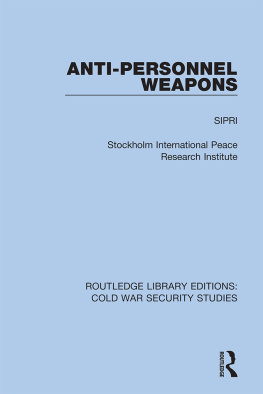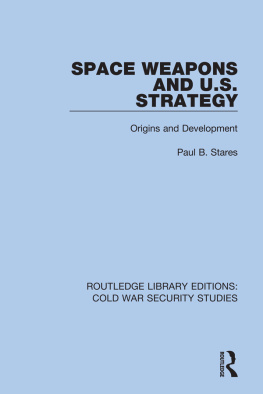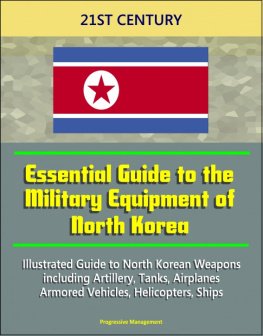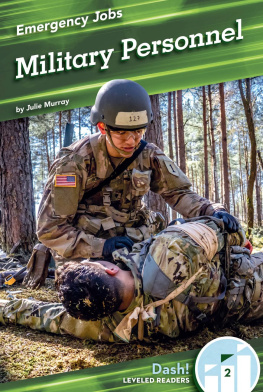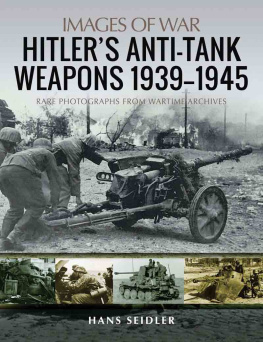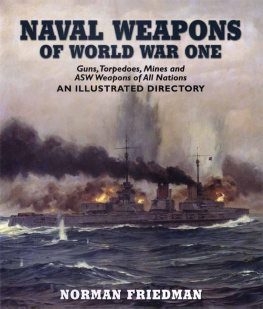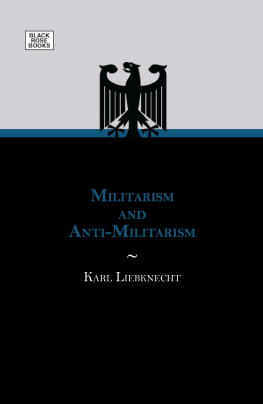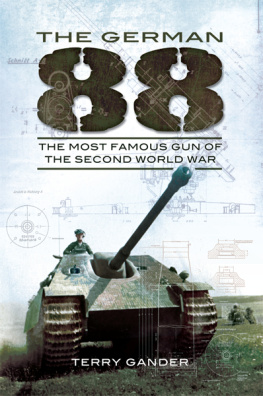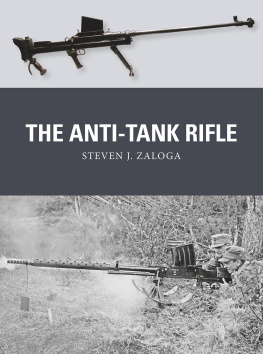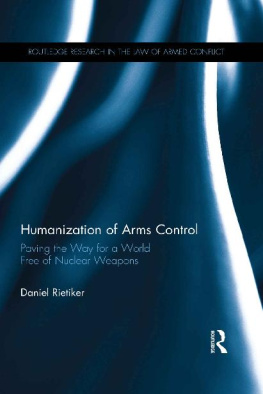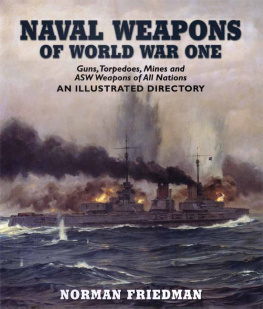ROUTLEDGE LIBRARY EDITIONS: COLD WAR SECURITY STUDIES
Volume 3
ANTI-PERSONNEL WEAPONS
Anti-Personnel Weapons
Sipri
Stockholm International Peace Research Institute
First published in 1978 by Taylor & Francis Ltd
This edition first published in 2021
by Routledge
2 Park Square, Milton Park, Abingdon, Oxon OX14 4RN
and by Routledge
52 Vanderbilt Avenue, New York, NY 10017
Routledge is an imprint of the Taylor & Francis Group, an informa business
1978 SIPRI (Stockholm International Peace Research Institute)
All rights reserved. No part of this book may be reprinted or reproduced or utilised in any form or by any electronic, mechanical, or other means, now known or hereafter invented, including photocopying and recording, or in any information storage or retrieval system, without permission in writing from the publishers.
Trademark notice: Product or corporate names may be trademarks or registered trademarks, and are used only for identification and explanation without intent to infringe.
British Library Cataloguing in Publication Data
A catalogue record for this book is available from the British Library
ISBN: 978-0-367-56630-2 (Set)
ISBN: 978-1-00-312438-2 (Set) (ebk)
ISBN: 978-0-367-62373-9 (Volume 3) (hbk)
ISBN: 978-1-00-310914-3 (Volume 3) (ebk)
Publishers Note
The publisher has gone to great lengths to ensure the quality of this reprint but points out that some imperfections in the original copies may be apparent.
Disclaimer
The publisher has made every effort to trace copyright holders and would welcome correspondence from those they have been unable to trace.
Anti-personnel Weapons
sipri
Stockholm International Peace Research Institute
First published 1978 by Taylor & Francis Ltd
10-14 Macklin St, London WC2B 5NF
Copyright 1978 by SIPRI
Sveavgen 166, S-113 46 Stockholm
All rights reserved. No part of this publication may be reproduced, stored in a retrieval system or transmitted, in any form or by any means, electronic, mechanical, photocopying, recording or otherwise, without the prior permission of the copyright owner.
Distributed in the United States of America by Crane, Russak & Company, Inc.
347 Madison Avenue, New York, N.Y. 10017
and in Scandinavia by
Almqvist & Wiksell International,
26 Gamla Brogatan,
S-101 20 Stockholm, Sweden
ISBN 0 85066 128 5
Text set in 11/12 pt Photon Times,
printed by photolithography, and bound in Great Britain at The Pitman Press, Bath
Preface
This book describes the development, uses and effects of conventional anti-personnel weapons such as rifles and machine-guns, grenades, bombs, shells and mines. It is intended as a contribution to the ongoing efforts to prohibit or restrict the use of some of the more inhumane and indiscriminate of these weapons.
The most urgent requirement for the modernization of international humanitarian law is a rule prohibiting the use of nuclear weapons and other means of mass destruction, including chemical weapons. There is also a need to prohibit or restrict the use of certain so-called 'conventional' weapons. The most immediate requirements are as follows:
- a rule prohibiting the use of napalm and other incendiary weapons (including white phosphorus) against personnel, the human habitat and natural resources;
- a rule prohibiting high-velocity small arms projectiles designed to yaw significantly, break up or deform within 150 mm of soft tissue or tissue simulant;
- a rule prohibiting the use of cluster bombs and shells and other area fragmentation munitions within a specified range of inhabited areas; and
- a rule requiring that all remotely delivered delayed-action weapons, including mines, should be fitted with a reliable neutralizing device, and prohibiting their use in inhabited areas.
In addition the implications of the development of fuelair explosives, uranium projectiles, laser weapons and other wave-propagation devices must be carefully considered.
This book was written by Dr Malvern Lumsden, a SIPRI Research Fellow.
Acknowledgements
Eric Prokosch, a visiting researcher at SIPRI in 1975, has made many invaluable contributions, notably in chapter 5. The editorial assistance of Rajesh Kumar is gratefully acknowledged.
Frank Barnaby
Director
March 1978
Abbreviations, Acronyms and Conventions
Abbreviations and acronyms
- AC Aircraft Cannon
- AR Assault Rifle
- CDDH Diplomatic Conference on the Reaffirmation and Development of International Humanitarian Law Applicable in Armed Conflicts
- CEP Circular Error Probable
- ECM Electronic Countermeasures
- FAC Forward Air Controller
- FAE FuelAir Explosive (also FAX)
- FAESHED FuelAir Explosive Helicopter Delivered
- FAX FuelAir Explosive (also FAE)
- FVG Fixed Vehicle Gun
- GP General Purpose
- HAR Heavy Assault Rifle
- HE High Explosive
- HEAT High-Explosive Anti-Tank
- HEI High-Explosive Incendiary
- ICRC International Committee of the Red Cross
- LASER Light Amplification by Stimulated Emission of Radiation
- LMG Light Machine-Gun
- LNG Liquid Natural Gas
- LORAN Long Range Navigation
- MAD Mass Air Delivery or Massive Assured Destruction
- MMG Medium Machine-Gun
- PE Probable Error
- PGM Precision-Guided Munition
- RII Relative Incapacitation Index
- RPV Remotely Piloted Vehicle
- SAR Search and Rescue or Short Assault Rifle
- SAWS Squad Automatic Weapon System
- SLUFAE Surface Launched FuelAir Explosive
- SPIW Special Purpose Individual Weapon
- SSB Salvo Squeezebore
- SSZ Special Strike Zone
- TEA Triethyl Aluminium
- WP White Phosphorus
Conventions
- .. Data not available
- Negligible; not applicable
Contents
- Chapter 1. The rise of anti-personnel weapons, from antiquity to 1900
- I. Early anti-personnel weapons
- II. Early firearms
- III. The rifle
- IV. The machine-gun
- V. Artillery
- VI. Rockets
- VII. The influence of weaponry on warfare
- VIII. Summary and conclusions
- Chapter 2. The rise of anti-personnel weapons, from World War I to the Viet Nam War
- I. World War I
- II. The inter-war period
- III. World War II
- IV. The Korean War
- V. The war in Indo-China, 1961-75
- Conventional high explosive munitions
- Bomblet dispenser systems and cluster bombs
- Gunships
- Scatterable mines
- Flechette munitions
- Fuel-air explosives
- Small calibre, high velocity assault rifles
- The 'electronic battlefield'
- Improvised munitions
- VI. The impact of the Viet Nam War on the arms race
- VII. The influence of weaponry on warfare
- VIII. Summary and conclusions
- Chapter 3. Projectile wounds and wound ballistics
- I. The study of wound ballistics

